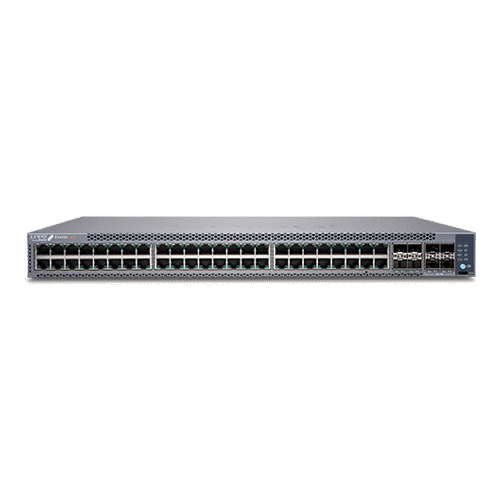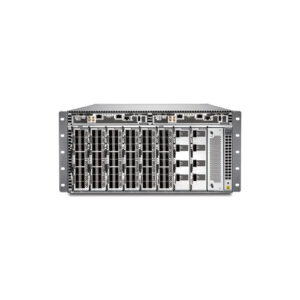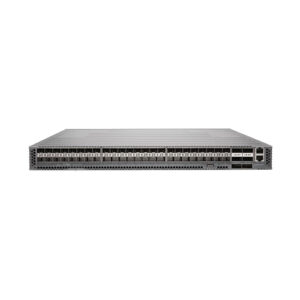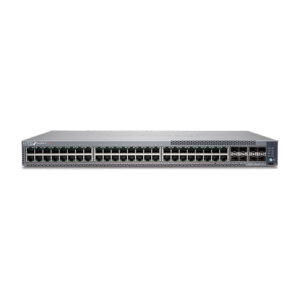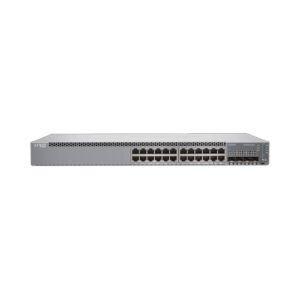Description
EX4100 Ethernet Switch
Crafted for high-performance branch deployments, the Juniper Networks EX4100 Ethernet Switch is an AI-driven, cloud-ready access switching platform. Built with leading-edge technologies, it’s differentiated by features such as EVPN-VXLAN, microsegmentation using group-based policies (GBP), MACsec AES-256, Power over Ethernet (PoE+), Precision Timing Protocol – Transparent Clock, and flow-based telemetry.
As part of the underlying infrastructure for Juniper Mist™ Wired Assurance, the EX4100 Ethernet Switch is easy to onboard, configure, and manage. Juniper Mist Cloud streamlines deploying and managing your campus fabric, while Mist AI™ simplifies operations and improves visibility into the performance of connected devices.
EX4100 models:
EX4100-24P/T: 24 x 1GbE PoE/Non-PoE, 4 x 1/10GbE uplinks, and 4 x 10/25GbE stacking/uplinks
EX4100-48P/T: 48 x 1GbE PoE/Non-PoE, 4 x 10GbE uplinks, and 4 x 10/25GbE stacking/uplinks
Key Features
Port density : 1GbE access ports, 10/25 GbE uplink/stacking, 1/10GbE uplink
Form factor : 1 RU
Power : PoE+ up to 30W per port, 1440W PoE for EX4100-48P, and EX4100-24P
Switching capacity : 376 Gbps
Fabric : EVPN-VXLAN, Virtual Chassis
Features + Benefits
AI-Driven Switching
Onboard (day 0), provision (day 1), and manage (day 2+) the EX4100 from the cloud with Juniper Mist Wired Assurance, using AI-driven automation and insights to deliver improved experiences for IT staff, end users, and connected devices.
Streamline IT operations, reduce mean time to repair, and deliver a new generation of wired and wireless networks. The EX4100 provides rich streaming telemetry data for insights into switch health and wired service-level expectations (SLEs) for pre- and post-connection metrics.
End-to-End Campus Fabrics
Scale with ease, build resiliency, and streamline management with Virtual Chassis and EVPN-VXLAN-based campus fabrics, which help to simplify configuring and maintaining multiple devices.
Deploy this switch in a scalable and flexible EVPN-VXLAN campus fabric with a few clicks in the Mist dashboard, using the AI-driven Campus Fabric tool. Extend EVPN-VXLAN from the campus core to the distribution layer and access layer for simpler management and greater control and segmentation of endpoints. The EX4100 supports a Layer 3 IP-based underlay and EVPN-VLXAN overlay to interconnect multiple sites.
Microsegmentation
Standards-based microsegmentation using group-based policies (GBP) leverages underlying VXLAN technology to provide agnostic endpoint access control for consistent security policies and granular control of application, business function, or user tags.
Take segmentation to the next level by separating traffic within the same VLAN so IoT devices or users can traverse any port or switch within the network; maintain the same security policies without having to manually configure them each time.
Flow-Based Telemetry
Enables per-flow level analytics, so you can monitor thousands of traffic flows per switch without impacting the CPU.
For example, in the case of a DDoS attack, when flow thresholds are breached, the attack can be quickly detected. You can implement automated workflows to triage problems, such as quarantining a port or examining the traffic.
PoE, PoE+, Fast and Perpetual PoE
The EX4100 Switch offers fast and perpetual PoE that enables consistent power to be provided to the endpoints, even when the switch is rebooting. The switch also support a fast PoE capability that delivers PoE power to connected endpoints during a switch power-up, even before the switch is fully operational.
Encrypted Network Traffic with MACSec Support
EX4100 switches support IEEE 802.1ae MACsec 256, providing support for link-layer data confidentiality, data integrity, and data origin authentication. MACsec AES256 increases point-to-point security to protect customer traffic from unauthorized access, making your network more secure.
Precision Time Protocol Clock Built In (PTP)
EX4100 switches support Precision Time Protocol (PTP), also known as IEEE 1588v2.
This is a packet-based technology that enables the operator to deliver synchronization services on packet-based mobile backhaul networks. The IEEE 1588 PTP (Version 2) clock synchronization standard is a highly precise protocol for time synchronization that synchronizes clocks in a distributed system. The time synchronization is achieved through packets transmitted and received in a session between a primary clock and a client clock.

